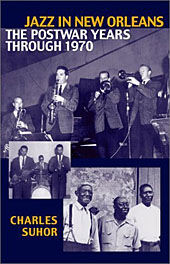Home » Jazz Articles » Book Excerpts » Strippers and Be-Boppers in Postwar New Orleans Jazz
Strippers and Be-Boppers in Postwar New Orleans Jazz
 New Orleans was a hotbed of jazz activity in many styles during the years after World War II, but it has been largely unrecognized by critics and historians. Beginning in 1948, trumpeters Sharkey Bonano, Papa Celestin, and Tony Almerico led a lively popular revival of traditional and Dixieland jazz, winning large followings in the city. Bonano's Kings of Dixieland were followed by a second line of young players—the Dukes of Dixieland, Pete Fountain, the Basin Street Six, and others. Veterans like George Lewis and Paul Barbarin also led popular bands.
New Orleans was a hotbed of jazz activity in many styles during the years after World War II, but it has been largely unrecognized by critics and historians. Beginning in 1948, trumpeters Sharkey Bonano, Papa Celestin, and Tony Almerico led a lively popular revival of traditional and Dixieland jazz, winning large followings in the city. Bonano's Kings of Dixieland were followed by a second line of young players—the Dukes of Dixieland, Pete Fountain, the Basin Street Six, and others. Veterans like George Lewis and Paul Barbarin also led popular bands.Ironically, the French Quarter was at the same time the underground setting for modern jazz. This exciting movement was virtually unknown outside the gatherings of young players who were discovering and advancing the revolutionary music. It wasn't until the current generation of modernists—the Marsalis Brothers, Harry Connick, Jr., Nicholas Payton, Terence Blanchard, Irvin Mayfield, and others—that New Orleans artists were widely thought of as adept in post-Dixieland styles.
But today's successful modernists are standing on the shoulders of largely invisible giants. No one would claim that New Orleans musicians invented the new music, but the city's early boppers were certainly on the cutting edge. They were brilliant, impoverished, and relentless. Unable to make a living in a city devoted to early jazz and the emerging rhythm and blues, they played jam sessions at each other's houses and after-hours sessions. The only venue for steady employment was French Quarter strip clubs, where the modern jazz was heard by audiences who clearly were not there for the music.
Musicians from other parts of the country were attracted to the city's freewheeling lifestyle. The Quarter's bohemian atmosphere had not yet become a badge of hipness sported by middle class émigrés and exploited by studiedly quaint boutiques. Among the loosely knit community of locals and visitors who worked the strip clubs were Al Belletto, Mouse Bonati, Sam Butera, Benny Clement, Fred Crane, Tony D'Amore, Johnny Elgin, Bill Evans, Don Guidry, Pete Kowchak, Black Mike Lala, Bruce Lippincott, Tony Mitchell, Brew Moore, Joe (Cheeks) Mandry, Joe Morton, Fred Nesbitt, Earl Palmer, Joe Pass, Bill Patey, Chick Power, Pete Monteleone, Mike Serpas, Frank Strazerri, Don Suhor, Bob Teeters, and Louis Timken.
Joe Pass, later famed as the guitarist with Oscar Peterson, played the strip clubs for ten months. He told jazz writer Rhodes Spedale that "after 3 a.m. we could jam, and that's what kept me here. In 1949 there was as much good jazz and good players happening here as in, say, Chicago. You could live here relatively cheap and you could play—all night and all day."
But the strip clubs settings were typically dingy, and the dancing artless. Strippers disrobed while walking arhthymically across the stage, embellishing the stroll with bumps and grinds. B-girls and prostitutes worked the dark, ill-smelling rooms, soliciting watered-down drinks and sometimes "rolling" hapless customers (i.e., robbing them after drugging or clobbering them). A variety of narcotics was available, and they took their toll on musicians, entertainers, and prostitutes.
In the early 1950s a few French Quarter clubs, led by the Sho'Bar and Prima's 500 Club, aspired to the dubious status of classy exotic dance nitery. On the theory that gauche is a step up from sordid, they featured better-known strippers or those who had a gimmick—Candy Barr, Lily Christine (the Cat Girl), Evangeline (the Oyster Girl—the slimy mollusks would slide seductively down her body), Kalantan, Allouette (who twirled tassels that were affixed to pasties on her nipples), Sally Rand, Blaze Starr (Governor Earl K. Long's mistress), and Stormy, whose success led to a follow-up act, Stormy's Mother.
Only in New Orleans: in the squeaky-clean fifties, the Sho'Bar had a daytime radio show. Comedian/emcee Lenny Gale touted the club's strippers and the vulgarian red-hot-momma Carrie Finnell with the energy and aplomb of today's infomercial hosts. The patina of respectability failed to cover a multitude of vices. Comedian Frankie Ray told David Cuthbert in a Times-Picayune article that the Latin Quarter Club of 1949 as "a real den of iniquity" and the Treasure Chest as "the worst ***** house on the street."
Not every strip club in the Quarter hired jazz musicians, but among those where modern jazz was played behind dancers or at after-hours sessions were the Gunga Den, Prima's 500 Club, French Opera House, Old Opera House, Puppy House (later called the Sho'Bar), Stormy's Casino Royal (later Dan's Pier 600, then Al Hirt's), Club Slipper (later, the Dream Room). Another club, the French Casino, was away from the river on Canal Street between Rampart and Claiborne, near the Texas Lounge jazz, a true modern jazz oasis where drummer Earl Palmer, pianist Ed Frank, and others played with vocalist Earl Williams.
For a variety of reasons, modern jazz was acceptable accompaniment behind the dancers and in between introductions and chasers for the comics and other post-vaudeville acts at the clubs. Since there was seldom any attempt to depict the stripping as a species of terpsichorean art, it mattered little what the background music was like, so long as the drummer caught the bumps and grinds. Also, there was an aptness of sorts in the very unfamiliarity of the new music. Its heavily accented phrases and "weird" harmonies became part of the decidedly countercultural, borderline verboten ambience. In the absence of musical freedom of any sort in most other venues, many modern jazz artists chose to make a living in the strip clubs.
Jazz-for-strippers had some built-in musical problems, of course. Some dancers and club owners allowed little or no freedom. They wanted to hear the clichés of exotic pit band music, e.g., a slurpingly seductive sax, a growling trumpet—as if the customers were actually listening. And as anyone who has ever seen a classic strip show knows, the drummer's role is inherently invasive. The music, whatever the style, is pitted against rim shots, rolls, cymbal crashes, and tom-tom and bass drum thrusts coordinated with the dancer's gyrations, all without losing the basic beat. Percussively, a challenge. Musically, a triple-forte nuisance.
But not a stopper. Amazingly, jazz accompanists were relentless and could often play wonderfully amidst the random percussion accents. It seemed that they were not so much mentally blocking out the din as visualizing it as an asymmetrical phenomenon that was part of the performance, like the Kafka tale where the frequent disruption of a ceremony by a leopard was handled by making the leopard a part of the event.
The French Quarter clubs of the early postwar years were almost exclusively for white audiences, and white musicians had most of the jobs at strip clubs. Some exceptions were recalled by bassist Richard Payne and drummer Earl Palmer. Payne, who played with early greats like Ed Blackwell, James Black, Ellis Marsalis, Nat Perrilliat, and others, remembers trumpeter Thomas Jefferson's description of a strip gig. The black band had to play for strippers from behind a curtain, invisible to the white audience.
As modern jazz attracted more fans in the late fifties and early sixties, concerts and weekend gigs and steady work became more common. At the Playboy on Iberville near Bourbon, Al Belletto performed and booked modern jazz combos regularly beginning in 1962. He also led the first openly integrated combo there in 1964. Pianist Ronnie Kole's trio gained a following with showmanly Peter Nero-type performances at his Quarter Club. Ellis Marsalis led excellent groups at Marsalis' Mansion, his father's club that was attached to a motel. I played drums with Pianist Buddy Prima and then-guitarist Bill Huntington at Leon Prima's Fountain Lounge in Lakeview. Saxophonist Red Tyler, pianist Joe Burton, and others found audiences in town. Saxophonist Harold Battiste recorded the marvelous American Jazz Quintet on the AFO label, one of the few recorded examples of the city's modern jazz players
While none of these breakthroughs amounted to wild prosperity, modern jazz had come out of the closet, no longer limited to the seamy underworld of strip clubs or floating jam sessions at musicians' homes and after-hours clubs. National fame would await the next generation of modernists, but at least the was a civic sense of a jazz community broader than the traditional and Dixieland jazz styles that had exclusively dominated the city's image for half a century.
Learn more about Jazz in New Orleans: The Postwar Years Through 1970.
© 2001, Charles Suhor
< Previous
Momenta
Next >
Simply Put
Comments
Tags
Book Excerpts
Charles Suhor
United States
Louisiana
New Orleans
Harry Connick, Jr.
Nicholas Payton
Terence Blanchard
Irvin Mayfield
Joe Pass
Ellis Marsalis
For the Love of Jazz
 All About Jazz has been a pillar of jazz since 1995, championing it as an art form and, more importantly, supporting the musicians who create it. Our enduring commitment has made "AAJ" one of the most culturally important websites of its kind, read by hundreds of thousands of fans, musicians and industry figures every month.
All About Jazz has been a pillar of jazz since 1995, championing it as an art form and, more importantly, supporting the musicians who create it. Our enduring commitment has made "AAJ" one of the most culturally important websites of its kind, read by hundreds of thousands of fans, musicians and industry figures every month.























